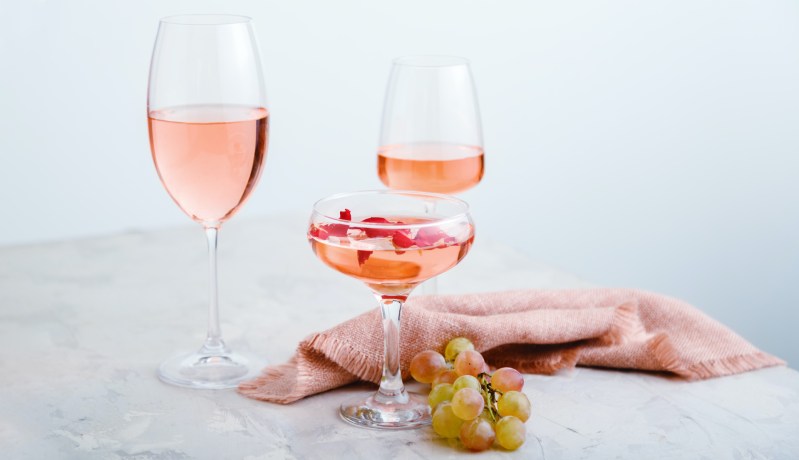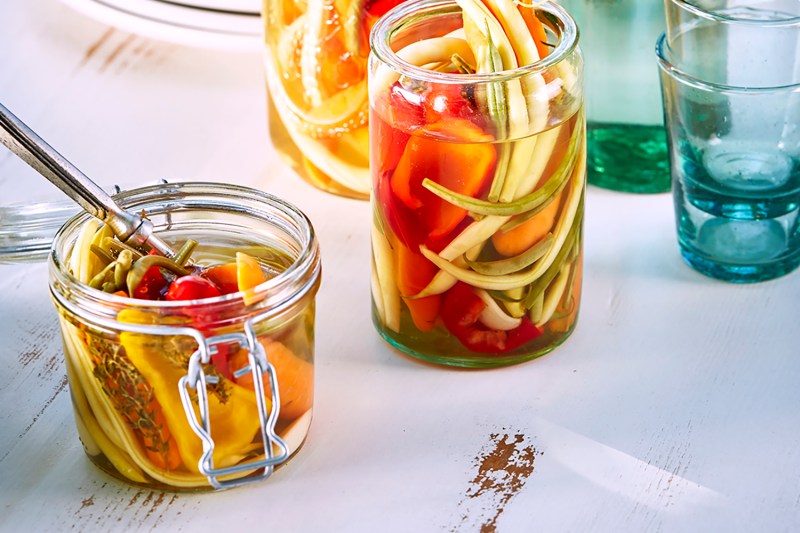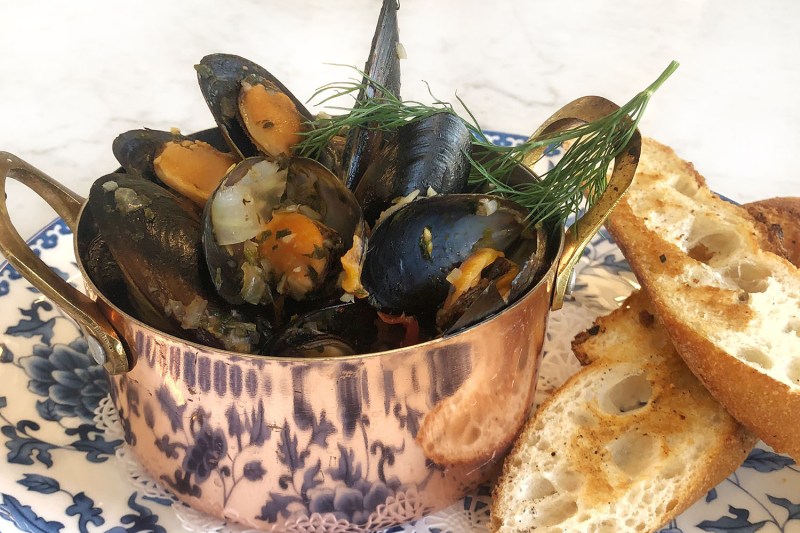
Wine plays an integral role in many different international cuisines, both as an accompaniment to a meal and as a crucial recipe ingredient. It’s easy to find dishes that incorporate white wine or red wine … but rosé, the blush vino that’s experienced a major popularity renaissance in recent years, tends to get the short shrift from a culinary standpoint. So that leaves the question, can you cook with rosé wine? The answer is yes, according to our expert sources, rosé has just as much relevance as a cooking wine as its red and white counterparts. But for any skeptics about cooking with wine out there, we’ve got 4 solid reasons to try cooking with rosé, along with rosé-centric recipes.

Reasons to cook with rosé
Rosé provides remarkable versatility when used for cooking
In terms of weight, texture, and — in many cases — flavor, rosé often seems to have more in common with white wine than with red wine. However, because rosé is made from red grapes (rather than a mixture of red and white wines, as many folks mistakenly believe), it can substitute for either type of vino during the cooking process, as long as the person in the kitchen knows what they’re doing.
“Rosé is super versatile in the kitchen. I tend to treat rosé more like a white wine, but it can flex either way,” said chef Pieter Sypesteyn, who is now the executive chef at Nola Brunch & Beignets in San Antonio, Texas.
As far as specifics go, Sypesteyn has a few intriguing suggestions to share:
- I prefer cooking with a dry rosé, so you can adjust the sweetness based on what you’re cooking.
- I love to use [a combination of] rosé and vermouth, along with fennel and spring onions, to braise beef short ribs. It takes a traditionally rich and savory dish and brings a lighter and more aromatic twist.
- You can also [use rosé to] make a great sauce for meat and fish dishes. Instead of using beef or chicken stock, use carrot or orange juice as your base, and add a splash of rosé for some acidity and aromatic components.
- Rosé is also great for desserts, like poached pears or granita. I love to poach pears in a mixture of rosé, sugar, star anise, cinnamon, Meyer lemon peel, and bay leaf. The poached pears are great when chilled in that poaching liquid and served with lightly sweetened Neufchatel or creme fraiche and some salted Marcona almonds.
- You can then take that poaching liquid and make a great granita by freezing it on a baking sheet and stirring with a fork every 30 minutes or so until completely frozen. That granita would go great on raw oysters on the half-shell, or by itself after dinner.
Remember that all rosés are not created equal
It’s tempting to assume that all pink wines feature similar flavor profiles … but nothing could be further from the truth. Head chef Jessica Randhawa of The Forked Spoon tells us that “when picking a rosé to cook with, one should know that not all rosé wines are the same. Traditionally, Americans drink rosé made from Pinot Noir (earthier and much less floral) or White Zinfandel (much sweeter). Provençal rosés, however, are mostly made from Syrah and Grenache, which are less sweet.”
While selecting a rosé to use in a recipe, consider the flavor profiles of the dish and pick a bottle that will prove complementary. Don’t be afraid to do some research — and if you’re feeling stuck, ask the wine store workers for a recommendation.
If a recipe calls for white wine, feel free to swap in rosé
As we mentioned previously, rosé makes a seamless replacement for white wine in a multitude of recipe contexts. Chef and instructor Rosa Jackson of Les Petits Farcis in Nice, France provides the following example of a dish that similarly utilizes rosé to white wine: “I also use rosé much as I would use white wine in cooking — one example is in an artichoke stew called artichauts à la barigoule, in which the artichokes are stewed with carrot, onion, bacon, and wine. I find the rosé adds just a little bit of sweetness that makes the dish even better (despite the fact that southern French rosés don’t taste sweet when you drink them).”
Rosé can also replace red wine in a recipe, especially if you’re making a sauce
Rosé may involve red grapes, but because it differs significantly from many red wines in terms of its weight, tannic structure, and overall taste, drinkers and cooks often assume that using rosé instead of red wine in a recipe will yield inconsistent results. But if you’re flexing your muscles as an amateur saucier, then trading in the red wine for a rosé can absolutely work to your advantage, according to executive chef Christopher Gross of The Wrigley Mansion in Phoenix, Ariz.
“Rosé is excellent when used to make sauces for more boldly flavored fishes. It reduces nicely and can [in fact] be used for a variety of sauces, in place of red wine,” Gross insists. If you want to try replacing red wine with rosé for sauce-making purposes but aren’t sold on the concept yet, seek out a darker-hued rosé with a more robust flavor, like the rosés commonly produced in Italy.
Ready to hit the kitchen with a bottle of rosé in hand? Try these savory recipes, which both make excellent use of blush wine.

Quick-pickled rosé vegetables
(By Tracey Shepos Cenami, chef and cheese specialist, La Crema Winery)
At-home pickling projects have reached a new popularity peak in recent weeks, and if you’re in search of a pickle-brine recipe that works beautifully with spring produce, then this rosé-fueled version can deliver. “For applications like pickling or making a mignonette for oysters, a crisper rosé is preferred!” said Tracey Shepos Cenami, chef and cheese specialist at the La Crema Winery.
Ingredients:
- .5 lb baby carrots, trimmed and halved lengthwise
- .25 lb toy box sweet peppers, halved lengthwise and seeded
- .25 lb yellow wax beans, trimmed
- .25 lb green beans, trimmed
- 3 cups white vinegar
- 2 cups rosé (Shepos Cenami prefers La Crema Monterey Rosé of Pinot Noir)
- 1⁄3 cup sugar
- 2 tbsp kosher salt
- 6 fresh thyme sprigs
- 1 bay leaf
- 3 cloves garlic, sliced
Method:
- Divide the carrots, peppers, and yellow and green beans evenly between two 1-qt widemouthed jars.
- In a medium pot, combine the vinegar, rosé, sugar, salt, thyme, bay leaf, and garlic and bring to a boil over high heat, stirring to dissolve the sugar.
- Remove from the heat and carefully pour the hot brine over the vegetables, submerging them fully. Screw on the lids and let cool to room temperature.
- Refrigerate the vegetables for at least 24 hours before serving. The vegetables will keep in the refrigerator for up to 1 month.

Simple rosé mussels
(By Gianni Vietina, executive chef/co-owner, Bianca Bakery and Madeo Ristorante, Los Angeles)
Mussels cooked in white wine are a classic for a very good reason … but replacing the typical Sauvignon Blanc or Pinot Grigio with a clean and refreshing rosé gives the dish a unique and harmonious revamp. “Generally speaking, you can substitute rosé for white wines in recipes. A rosé from Provence is lighter not only in color, but also in body, and is more delicate in flavor. [In my view,] a Côtes de Provence [rosé] will be better with shellfish (like in the recipe below),” Gianni Vietina, the executive chef/co-owner of Bianca Bakery and Madeo Ristorante in Los Angeles said.
Ingredients:
- Olive oil (small amount, to taste)
- 3 lbs mussels, cleaned (scraped and beard removed)
- Minced shallots, to taste (optional)
- 5-6 garlic cloves, minced
- 1.5 cups rosé (Vietina prefers Chateau Sainte Marguerite, Peyrassol, or Domaines Ott Clos Mireille)
- 2 bunches of parsley, chopped
- Pinch of red pepper
- Diced fresh tomatoes, to taste
- Black pepper, to taste
- Salt, to taste
Method:
- Add chopped garlic, shallots, parsley, and red pepper to hot olive oil in a pan and cook over medium heat until color appears on the garlic and shallots.
- Add cleaned mussels to the pan and cook.
- After a few minutes, add the rosé.
- When the mussels open up, add the tomatoes and cook for a few more minutes, seasoning with salt and pepper to taste. Serve with toasted baguette slices.

Rosé chicken piccata
(By Grant Melton of Food 52)
For many of us, chicken piccata is a quick go-to recipe that can be easily whipped up on a weeknight for a simple but impressive Italian-inspired dinner. The dish likely evolved from veal piccata, which is still popular in Italy. The chicken breast cutlets are typically dredged in flour and then browned and served with a sauce of white wine, butter, lemon juice, and capers. This version of the classic dish substitutes rosé for the white wine and pink peppercorns for the traditional capers.
Ingredients:
- 2 boneless, skinless chicken breasts (approximately 1 pound)
- 1/4 cup flour
- 3 tablespoons olive oil
- 2 tablespoons butter
- 3 cloves of garlic
- 1 1/2 teaspoons pink peppercorns
- 1/2 cup rosé wine
- The juice of one lemon
- Chopped parsley (for garnish)
- Salt and pepper
Method:
- Butterfly each chicken breast, cutting it completely in half horizontally. Place a piece of plastic wrap over the top of the chicken breasts and pound them slightly until they are both about the same thickness. Discard the plastic wrap and season the chicken, using about 1 1/2 teaspoons of salt and 1/2 teaspoon of pepper. Dredge the chicken in the flour and set aside.
- Heat the oil in a pan over medium-high heat. Add the chicken, and brown for approximately 3 to 4 minutes per side. Once browned, remove the chicken from the pan.
- Melt the butter in the pan used to brown the chicken. Add the garlic and the pink peppercorns, stirring for a minute until the garlic starts to become fragrant.
- Add the rosé and lemon juice and bring to a boil. Boil for about 6 minutes or until the mixture is reduced by about a half.
- Add 1/2 teaspoon salt and whisk.
- Place the chicken breasts back into the pan and coat both sides with sauce. Serve with the parsley garnish and extra sauce.
Editors' Recommendations
- How to brunch like the French with lobster croissant and champagne
- Your guide to the pescatarian diet for healthier living
- Get creative: How to use hibiscus in your cocktails this spring
- The 10 best brunch recipes for restaurant-quality meals at home
- The 10 best gins for a refreshing gin and tonic


